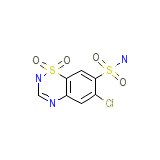Chloriazid




Chloriazid Brand names, Chloriazid Analogs
- Aldoclor
- Alurene
- CT
- Chloriazid
- Chlorosal
- Chlorothiazid
- Chlorthiazide
- Chlortiazid
- Chlorurit
- Chlotride
- Chlrosal
- Clotride
- Diupres
- Diuresal
- Diuril
- Diuril Boluses
- Diuril Lyovac [As Sodium Salt]
- Diurilix
- Diurite
- Diutrid
- Esidrix
- Flumen
- Hydro-D
- Hydrochlorothiazide
- Hydrochlorothiazide Intensol
- Hydrodiuril
- Lyovac Diuril [As Sodium Salt]
- Microzide
- Minzil
- Neo-Dema
- Oretic
- Salisan
- Salunil
- Saluretil
- Saluric
- Sk-Chlorothiazide
- Thiazide
- Urinex
- Warduzide
- Yadalan
- Zide
Chloriazid Brand Names Mixture
- Supres 150 Tab (Chlorothiazide + Methyldopa)
- Supres 250 Tab (Chlorothiazide + Methyldopa)
Chloriazid Chemical_Formula
C7H6ClN3O4S2
Chloriazid RX_link
http://www.rxlist.com/cgi/generic2/chloroth.htm
Chloriazid fda sheet
Chloriazid msds (material safety sheet)
Chloriazid Synthesis Reference
No information avaliable
Chloriazid Molecular Weight
295.725 g/mol
Chloriazid Melting Point
350 oC
Chloriazid H2O Solubility
266 mg/L
Chloriazid State
Solid
Chloriazid LogP
0.549
Chloriazid Dosage Forms
Tablet (250, 500 mg)
Chloriazid Indication
Chlorothiazide is indicated as adjunctive therapy in edema associated with congestive heart failure, hepatic cirrhosis, and corticosteroid and estrogen therapy. It is also indicated in the management of hypertension either as the sole therapeutic agent or to enhance the effectiveness of other antihypertensive drugs in the more severe forms of hypertension.
Chloriazid Pharmacology
Like other thiazides, chlorothiazide promotes water loss from the body (diuretics). It inhibits Na+/Cl- reabsorption from the distal convoluted tubules in the kidneys. Thiazides also cause loss of potassium and an increase in serum uric acid. Thiazides are often used to treat hypertension, but their hypotensive effects are not necessarily due to their diuretic activity. Thiazides have been shown to prevent hypertension-related morbidity and mortality although the mechanism is not fully understood. Thiazides cause vasodilation by activating calcium-activated potassium channels (large conductance) in vascular smooth muscles and inhibiting various carbonic anhydrases in vascular tissue. Chlorothiazide affects the distal renal tubular mechanism of electrolyte reabsorption. At maximal therapeutic dosages, all thiazides are approximately equal in their diuretic efficacy. Chlorothiazide increases excretion of sodium and chloride in approximately equivalent amounts. Natriuresis may be accompanied by some loss of potassium and bicarbonate.
Chloriazid Absorption
No information avaliable
Chloriazid side effects and Toxicity
Oral, rat LD50: > 10 g/kg. Signs of overdose include those caused by electrolyte depletion (hypokalemia, hypochloremia, hyponatremia) and dehydration resulting from excessive diuresis. If digitalis has also been administered hypokalemia may accentuate cardiac arrhythmias.
Chloriazid Patient Information
Chloriazid Organisms Affected
Humans and other mammals














